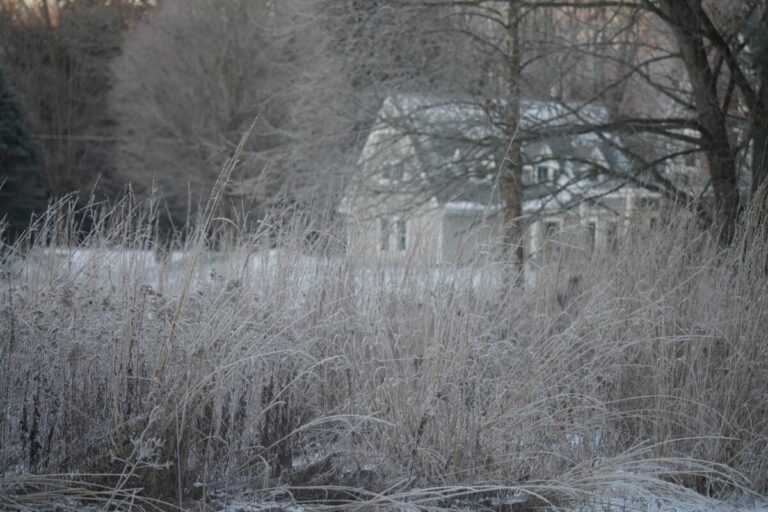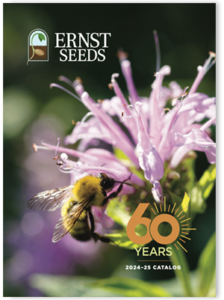While you’re hopefully bundled up in a warm place reading this blog, the pollinators that support our local ecosystems don’t have this luxury. They rely on overwintering strategies for shelter and insulation during the cold months.
Overwintering is a general term that describes how various species survive the cold. IIt’s not a universal strategy, but rather a diverse set of behaviors that have evolved over time.
Despite the variation in overwintering strategies among species and even life stages, you can directly support them via sustainable fall trimming practices.
Ahead, we’ll explain what you need to know about overwintering pollinators, why you should support them, and provide some practical tips that will help you modify your fall trimming accordingly.
Understanding Overwintering Pollinators
Overwintering pollinators are insects that survive the winter months by entering a dormant state. Different pollinators adopt various strategies to endure low temperatures, scarce food, and harsh conditions. Understanding these pollinator behaviors, and modifying your trimming practices in response, is a great way to help support pollinator populations year-round.
Common Overwintering Pollinators
Although many pollinators utilize overwinter strategies, their methods can vary. Some species bury themselves in the ground, while others look for shelter under bark, leaf litter, or other dense vegetation.
For example, queen bumblebees prepare for the winter by building up fat stores and mating. When the cold arrives, they hibernate underground in soil cavities or under leaf litter. They emerge in early spring to start new colonies.
Solitary bees, like mason bees and leafcutter bees, often use hollow stems or tunnels in wood to overwinter. They can also utilize pithy stems of plants to create nests.
Butterfly species such as the Mourning Cloak and the Eastern Comma overwinter as adults, hiding in tree bark or dense vegetation. Others, like the Black Swallowtail, overwinter as pupae attached to stems or plant debris. Many moth species overwinter in the larval or pupal stage within soil or leaf litter.
Becoming familiar with which pollinators are present in your area will not only help you ensure you choose the right native plants for their diet, but also develop maintenance practices to support them. For instance, leaving hollow-stemmed plants untrimmed provides nesting sites for solitary bees. Plants with pithy stems, like elderberry or sumac, are also valuable as they can be excavated by bees for nesting.
Life Stages of Overwintering Pollinators
Depending on the species and stage of life, various behaviors can be observed. For example:
- Eggs: Some species, like grasshoppers and solitary bees, lay eggs that overwinter and hatch in spring. The eggs are often laid in protected areas like soil, leaf litter, or plant stems.
- Larvae: Certain butterflies and moths overwinter as caterpillars. They hide under leaf litter or burrow into the ground to escape freezing temperatures.
- Pupae: Many species enter the pupal stage before winter, transforming into adults when warmer weather arrives. Examples include certain butterflies like swallowtails or skippers. Pupae are usually hidden in soil, plant debris, or within stems.
- Adults: Some pollinators, like adult bumblebees and certain butterflies, may overwinter as adults. They seek shelter in hollow stems, under bark, or in leaf litter.
Plant debris, leaf litter, and soil play a significant role as overwintering sites. They provide insulation, protection from predators, and stable microclimates. Altering your trimming practices to preserve these elements in your meadow ensures essential habitats for pollinators to survive the winter.
The Negative Impact of Fall Trimming on Pollinators
Fall trimming and garden cleanup, while aesthetically pleasing, can have detrimental effects on overwintering pollinators.
Removing plant debris, dead stems, and leaf litter eliminates crucial habitats needed for survival during winter. For example,
- Hollow Stems and Dead Wood: Many bees nest in hollow or pithy stems. Cutting these down in the fall destroys their nests and kills the developing bees inside.
- Leaf Litter: Butterflies and moths that overwinter as eggs, larvae, or pupae in leaf litter are removed when gardens are raked clean.
- Soil Disturbance: Tilling or disturbing the soil disrupts ground-nesting bees and insects hibernating just below the surface.
This kind of haphazard removal can have severe impacts on pollinators. Repeated destruction of overwintering habitats leads to a decrease in pollinator populations over time. This directly affects plant reproduction, leading to lower biodiversity and ecosystem health.
Best Practices for Trimming to Support Overwintering Pollinators
Adjusting the timing of your landscape maintenance is critical for supporting overwintering pollinators.
In the spring, before new plant growth reaches 2 inches in height, we recommend mowing the previous year’s straw close to the ground. This practice helps to clear away dead material while minimizing harm to emerging plants and pollinators. If the layer of straw is particularly thick, a two-pass mowing technique is effective:
- First Pass: Set your mower to its highest setting and mow the area to reduce the bulk of the straw.
- Second Pass: Mow perpendicular to the first pass at a lower setting of one to two inches. This helps to break up the clippings further, preventing them from smothering new plant growth.
Mowing in late winter or early spring, on a day when the soil is dry, minimizes soil compaction and avoids creating ruts. Wet soil is more susceptible to damage from heavy equipment, which can negatively impact soil structure and harm ground-nesting pollinators.
By waiting for dry conditions, you protect both the soil and the insects relying on it.
Rotational Mowing: A Sustainable Alternative to Fall Trimming
In general, we don’t recommend simply delaying trimming, but rather rotational mowing. This is the practice of leaving some straw standing over the winter. It can provide significant benefits to pollinators, such as:
Enhanced Shelter Availability and Protection
Leaving plant debris extends habitat availability and provides continuous shelter until pollinators emerge. Dead vegetation offers insulation against extreme cold, helping pollinators regulate their temperature and increase their chances of survival.
Supporting Varies Emergence Times
Part of the reason to become familiar with your local environment is the reality that not every pollinator species will emerge at the same time. Some bees emerge in early spring, while others don’t appear until late June. Leaving up to one-third of the meadow unmown ensures habitats are available for late-emerging species.
Rotational Mowing Strategy
Instead of simply delaying your mowing, we recommend you leave 1/3rd of your landscape untrimmed every year.
Rotate the unmown areas each year to prevent overaccumulation of debris and to distribute habitats evenly. Adjust these practices to align with local regulations and desired aesthetics while maximizing pollinator support.
By understanding the risks of fall trimming and the advantages of rotational mowing, you can make informed decisions that support pollinator health and contribute to a thriving ecosystem.
Ernst Can Help You Support Local Pollinators Year-Round
Tailoring your fall trimming to the needs of overwintering pollinators is a big step toward creating a more sustainable and vibrant landscape.
By modifying your trimming practices—such as mowing in early spring instead of fall and adopting rotational mowing—you provide essential habitats that help pollinators survive the winter. These small changes can lead to increased biodiversity and healthier plant growth.
Supporting pollinators requires a combination of dietary support and abundant overwintering habitats, and the native seeds that Ernst has in stock can help with both.
If you have questions or need guidance tailored to your specific situation, contact the experts at Ernst Conservation Seeds for more information.


